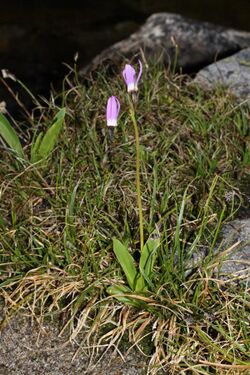Biology:Primula jeffreyi
This article needs additional citations for verification. (January 2024) (Learn how and when to remove this template message) |
| Primula jeffreyi | |
|---|---|

| |
| In Henry M. Jackson Wilderness | |
| Scientific classification | |
| Kingdom: | Plantae |
| Clade: | Tracheophytes |
| Clade: | Angiosperms |
| Clade: | Eudicots |
| Clade: | Asterids |
| Order: | Ericales |
| Family: | Primulaceae |
| Genus: | Primula |
| Section: | Primula sect. Dodecatheon |
| Species: | P. jeffreyi
|
| Binomial name | |
| Primula jeffreyi (Van Houtte) A.R.Mast & Reveal
| |
| Synonyms[1] | |
| |
Primula jeffreyi, synonym Dodecatheon jeffreyi,[1] is a North American species of flowering plant in the primrose family known by the common names Sierra shooting star, Jeffrey's shooting star, and tall mountain shooting star.
Description
It is a thick-rooted perennial with long, slightly wrinkled leaves around the base. It erects slim, tall, hairy stems which are dark in color and are topped with inflorescences of 3 to 18 showy flowers. Each flower nods, with its pointed center aimed at the ground when fresh, and becomes more erect with age. It has four or five reflexed sepals in shades of pink, lavender, or white which lie back against the body of the flower. Each sepal base has a blotch of bright yellow. From the corolla mouth protrude large dark anthers surrounding a threadlike stigma.
Etymology
The specific epithet jeffreyi is in honor of botanist John Jeffrey.
Distribution and habitat
This wildflower is native to western North America from California to Alaska to Montana, where it grows in mountain meadows and streambanks.
In culture
The flowers of this species were considered good luck by the Nlaka'pamux people, who used them as amulets and love charms.
References
- ↑ 1.0 1.1 "Primula jeffreyi (Van Houtte) A.R.Mast & Reveal". Plants of the World Online. Royal Botanic Gardens, Kew. https://powo.science.kew.org/taxon/urn:lsid:ipni.org:names:60447604-2.
External links
Wikidata ☰ {{{from}}} entry
 |

